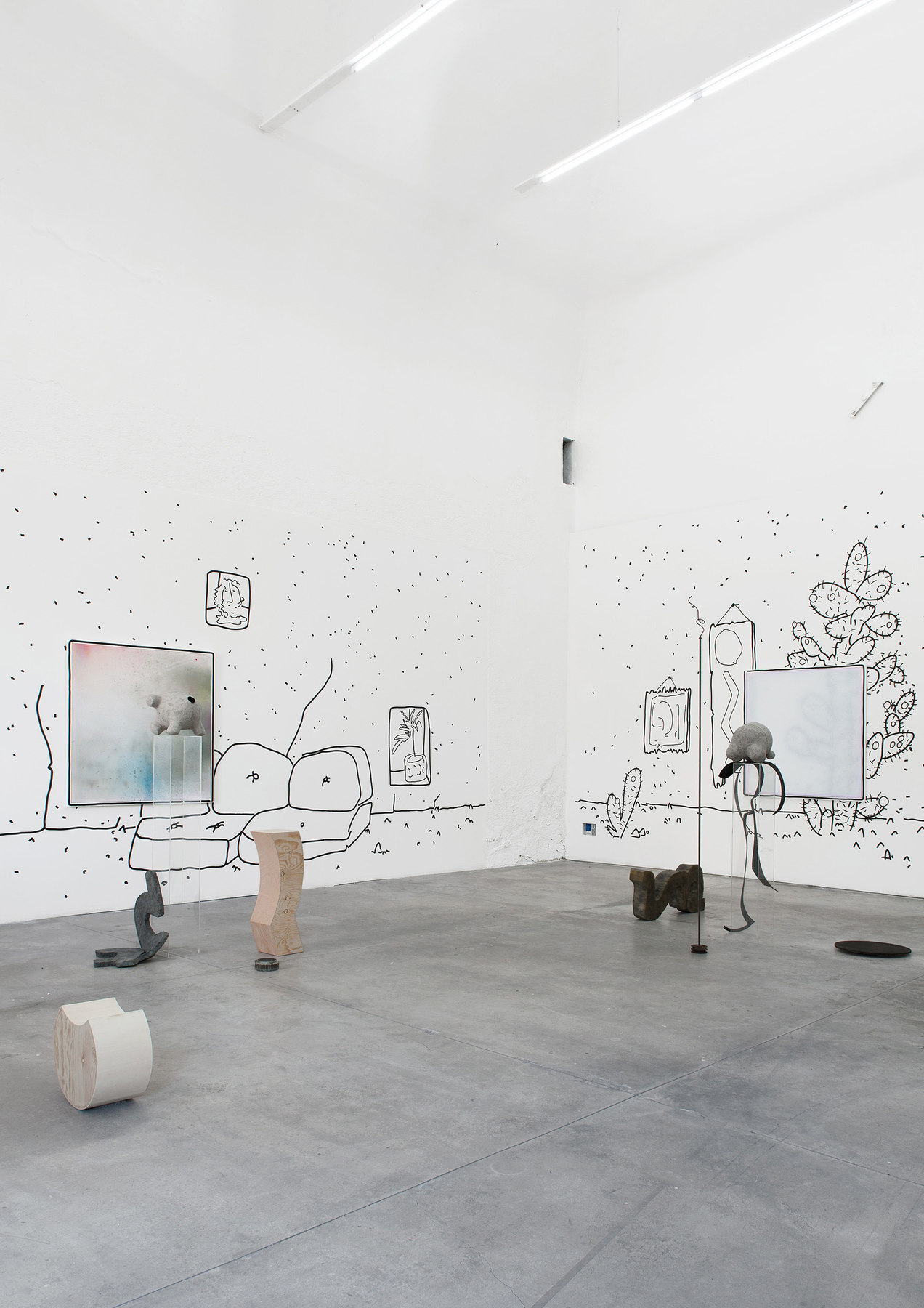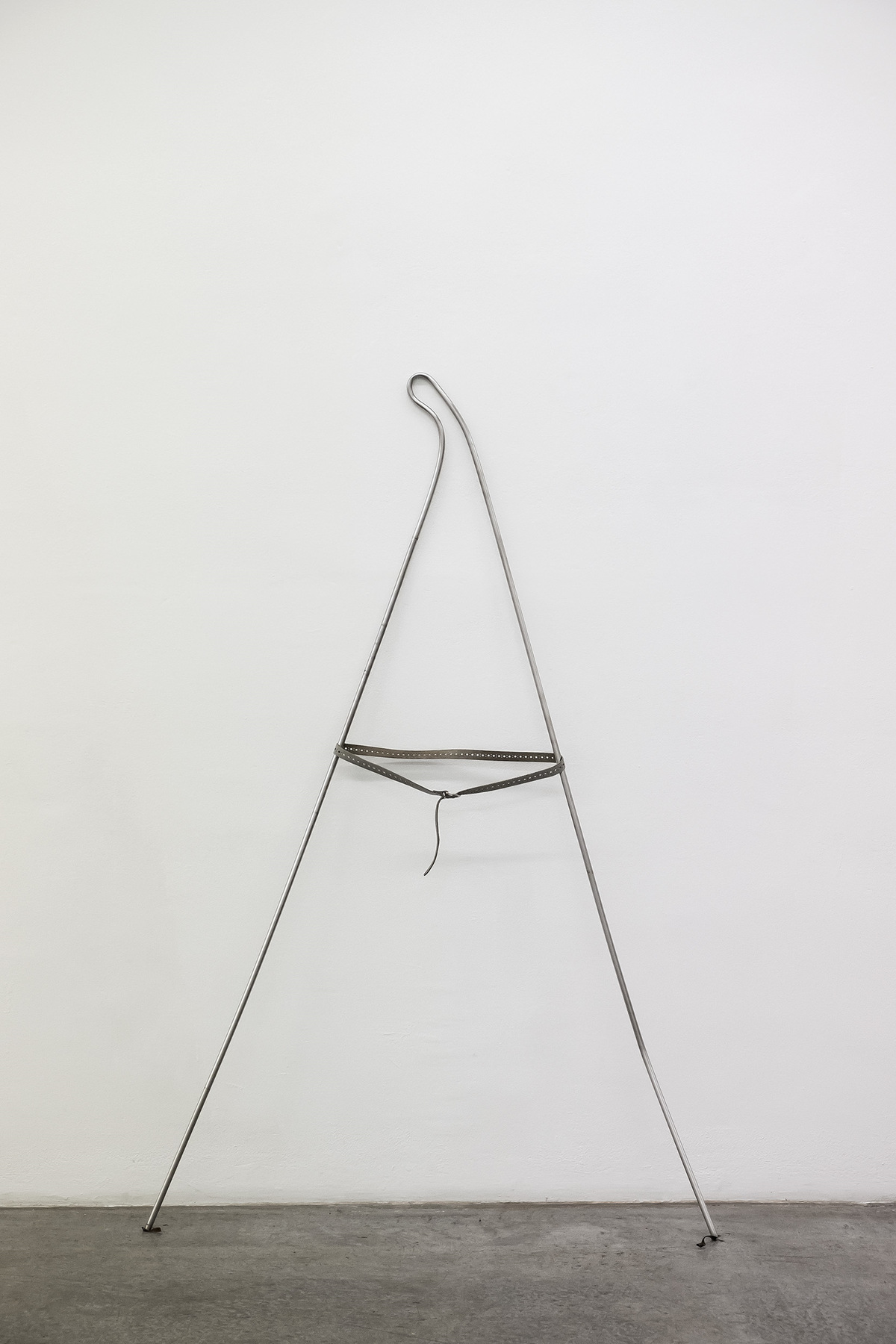Artists: Padhi Frieberger, Bruno Gironcoli, Sofia Goscinski, Nilbar Güreş, Lisa Holzer, Birgit Jürgenssen, Anita Leisz, Paul Leitner, Ute Müller, Julian Palacz, Signe Rose, Günther Selichar, Misha Stroj, Zin Taylor, Sofie Thorsen, Patrick Topitschnig, Kay Walkowiak
Exhibition title: ARTIFICIAL TEARS. Singularity & Humanness—A Speculation
Curated by: Janina Falkner (MAK Contemporary Art Collection) and Marlies Wirth (Curator, Digital Culture and MAK Design Collection)
Venue: MAK (MAK DESIGN LAB), Vienna, Austria
Date: June 21 – October 1, 2017
Photography: all images copyright and courtesy of the artists and MAK, Vienna
In a world increasingly shaped by digital technologies and interfaces, the significance of the relationships between humans and things becomes a focal point of interest. Against a backdrop of new digital and social settings, the group exhibition ich weiß nicht [I don’t know]—Growing Relations between Things spins a narrative about the affect of things via works by 17 contemporary artists, who are primarily living and working in Austria.
Objects—whether analog or digital—serve as tools (“media”) to configure our everyday surroundings and concomitantly shape our society. With the Internet of Things, smart devices, wearables, and apps, it appears as though the objects we have created are gaining ever more control over us humans. In this complex, networked world, how will it be possible to preserve or reclaim our autonomous, sovereign lives?
ich weiß nicht reflects upon the reality of things, upon the power of networks, upon sensuality and materiality, upon not-knowing, upon worrying, and upon letting go. The exhibition title is a concrete reference to the photographic work ich weiß nicht (2001) by Birgit Jürgenssen (1949–2003), which depicts the artist’s car snowed under in a parking spot. The no longer roadworthy conveyance becomes a vehicle for the artist’s breaking of a taboo—ich weiß nicht as a disarming human confession of relief in light of the failing machine, an alternative form of autonomy and mental “mobility.”
The relationships between things and people arise on many different levels at the same time: conscious and unconscious, spontaneous, ongoing, rarely not at all. This “economy of affects” is interesting with regard to the latitude wherein observers and objects operate: the “network power” of things does not reside in their ability to give specific instructions, but in creating the premises for relating to each other—and ultimately for relating to us.
A museum and an exhibition construct a space beyond everyday life in which objects—depending on context or location—act as community-builders: We look at them, circle them spatially and mentally, we try to understand them.
The things are our companions, tools for interaction, for living with each other and talking to one another. It seems as if conditions can be transferred and ceded to objects. Often things persist even beyond one’s own disappearance, like monuments.
Many of the artistic works shown in the exhibition ich weiß nicht thematize the moment of letting go—such as Nilbar Güreş’s Escaping Cactus (2014)—and the right moment to get involved. Misha Stroj’s intricate sculpture Io non aumento piu (2012), to which the artist’s belt is buckled, makes a statement about the presence or absence of an actor.
Motion recordings from security cameras are the source material for Julian Palacz’s Surveillance Studies (2017). An algorithm translates the computed routes of pedestrians, cars, and bicycles into vectors. Thus do technological instruments of control become designers of ephemeral drawings.
Narration is a fundamental element of graphical installations by Zin Taylor, who draws Return to the Canyon (2017) onto the wall in situ with markers. The space becomes a dynamic surface, an environment for reflection about artistic work per se: a place where things can be represented the way they are thought. Ute Müller’s sculptural arrangements emerge out of a process of repeatedly translating various forms, materials, and attributions of meaning. Between structure and “construct,” the artists lets raw materiality come into contact with familiar motifs and creates a poetic setting that—through recurrent transmission and superposition—allows varying interpretations.
Pigs’ ears as auratic figures in front of a monochrome background, reflection upon longing, reward, and transience: Lisa Holzer’s works Inducement (2016) seem like protagonists conveying emotions that do not confine themselves to what is portrayed. The reformulation of picture surface and meta surface gives rise to a dialog that literally “oozes out of the picture”, essentially in the form of polyurethane drops on the glass surface of the framed pigment print.
All areas of life, all the way to death, meanwhile are accompanied by machines. The archaic notion that burying a human being occurs by human hand is long since obsolete. In Patrick Topitschnig’s video work Mark&Garry (2013), massive excavator buckets function as gravediggers, while Mark and Garry talk about their work at the Melbourne General Cemetery. Silent and calm, the trees sway behind the rows of gravestones, which serve as markers and proxies calling to mind the erstwhile human presence.
The confrontation with our things, our inventions, and “self-expansions” opens up new fields of interaction. It is not only in the context of the museum that objects act as parts of ever new networks in a world beyond their creators. The idea for the exhibition ich weiß nicht arose from the awareness that we enter into reciprocal relationships with things through our actions—our work. Even the curatorial work process itself again and again evinces astonishment at how relations between things grow.
Misha Stroj, Io non aumento più (versione fanfarone), 2012; Artist’s belt, aluminum, © Misha Stroj/photo: Karl Kühn; Courtesy of the artist and Kerstin Engholm Galerie
Nilbar Güreş, Place a tree in front of TV, 2014; Fabric paint, fabric, button and embroidery on black fabric © Nilbar Güreş/photo: Markus Wörgötter; Courtesy of Galerie Martin Janda, Vienna
Birgit Jürgenssen, ich weiß nicht [i don’t know], 2001; Color photography on canvas; in the foreground: Renault 4 © Wolfgang Woessner/MAK
Ute Müller and Zin Taylor, The Canyon, 2016. Installation view, Galleria Collicaligreggi, Catania, 2016 © Ute Müller and Zin Taylor/photo: Ute Müller. Courtesy of the artists, Galleria Collicaligreggi, and Supportico Lopez Berlin
Julian Palacz, Surveillance Studies 11063, 2017. Pigment print on paper, TFT screen © Julian Palacz
Patrick Topitschnig, Mark&Garry, 2013; Film still © Patrick Topitschnig
Lisa Holzer, Inducement, 2016; Pigment print on cotton paper, epoxy resin, polyurethane on glass © Lisa Holzer; Courtesy Galerie Emanuel Layr
Exhibition View VIENNA BIENNALE 2017: Robots. Work. Our Future, ich weiß nicht [I don’t know]—Growing Relations between Things, MAK DESIGN LAB © Stefan Lux/MAK
Exhibition View VIENNA BIENNALE 2017: Robots. Work. Our Future, ich weiß nicht [I don’t know]—Growing Relations between Things, MAK DESIGN LAB © Stefan Lux/MAK
Exhibition View VIENNA BIENNALE 2017: Robots. Work. Our Future, ich weiß nicht [I don’t know]—Growing Relations between Things, MAK DESIGN LAB © Stefan Lux/MAK
Exhibition ViewVIENNA BIENNALE 2017: Robots. Work. Our Future, ich weiß nicht [I don’t know]—Growing Relations between Things, MAK DESIGN LAB; from left to right: Paul Leitner, Paperjack, 2017; Nilbar Güreş, Escaping Cactus, 2014; Nilbar Güreş, Place a tree in front of TV, 2014; Misha Stroj, Io non aumento piu (versione fanfarone), 2012 © Stefan Lux/MAK
Exhibition View VIENNA BIENNALE 2017: Robots. Work. Our Future, ich weiß nicht [I don’t know]—Growing Relations between Things, MAK DESIGN LAB; Sofie Thorsen, Precious Things That come Out of the Ground, 2017 © Stefan Lux/MAK
Exhibition View VIENNA BIENNALE 2017: Robots. Work. Our Future, ich weiß nicht [I don’t know]—Growing Relations between Things, MAK DESIGN LAB © Stefan Lux/MAK
Exhibition View VIENNA BIENNALE 2017: Robots. Work. Our Future, ich weiß nicht [I don’t know]—Growing Relations between Things, MAK DESIGN LAB; Zin Taylor and Ute Müller, Return to the Canyon, 2017 © Stefan Lux/MAK
Exhibition View VIENNA BIENNALE 2017: Robots. Work. Our Future, ich weiß nicht [I don’t know]—Growing Relations between Things, MAK DESIGN LAB © Stefan Lux/MAK
Exhibition View VIENNA BIENNALE 2017: Robots. Work. Our Future, ich weiß nicht [I don’t know]—Growing Relations between Things, MAK DESIGN LAB; from left to right: Sofia Goscinski, Untitled (I killed my Angsthase), 2014; Birgit Jürgenssen, ich weiß nicht, 2001 © Stefan Lux/MAK
















